
Ephemera: Games, Toys, Playing Cards, License Plate Decorations
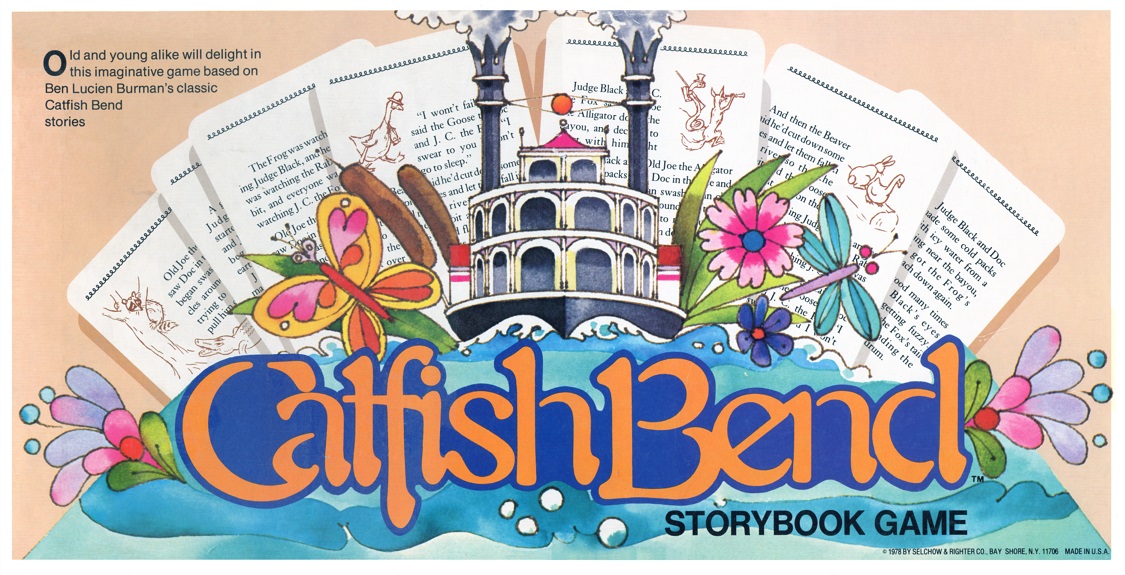
Catfish Bend Storybook Game - 1978
(composite of game box cover attached)
Old and young alike will delight in this imaginative game based on Ben Lucien Burman's classic Catfish Bend stories.
Doc, Judge Black, J.C. the Fox, Rabbit, Frog, Old Joe the Alligator, Beaver, Goose, City Fox, City Rat and Bloodhound ... all the Catfish Bend characters come to life in this unique reading game.
Players compete to collect the most characters after moving along the colorful Mississippi River.
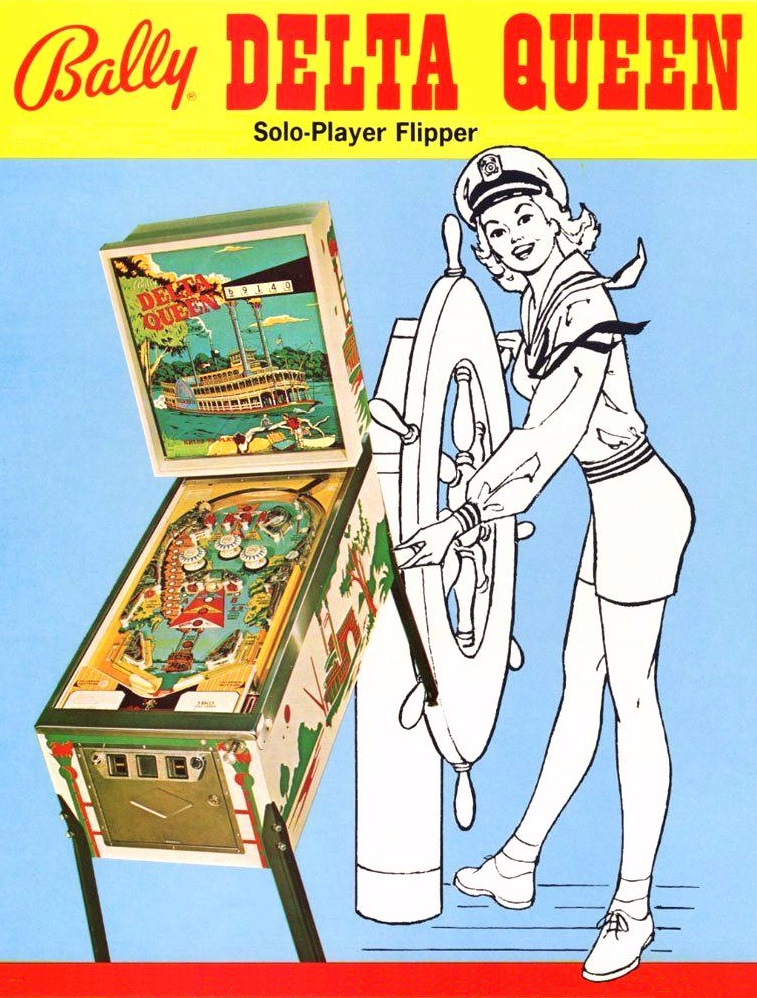
Delta Queen Arcade Pinball Machine FLYER 1974 listed in March 2019 by PinballArcadeArt on ETSY
The art representing the DELTA QUEEN is based on a classic sidewheel steamboat of the 1800's rather than the Sacramento River style of the DQ and DELTA KING.
Delta Queen Arcade Pinball Machine FLYER 1974
Original circa 1974 vintage paper promotional sales flyer for coin operated amusement arcade game.
Flyers were also called circulars, brochures, or fliers. Size is 8.5" X 11." Artwork on both sides.

Quaint box cover graphics for board game from Cadaco-Ellis Inc. 1939. 12 X 17 inches. I haven't scanned the board itself, just this crazy cover depicting honeysuckle and moonlight nostalgia, but with unfortunate racist cliches. The color graphic vignette is based on a Currier and Ives print. They gave a little nod to Mark Twain by christening the boat at the landing "Becky Thatcher." The boat approaching bears the name "Lee," probably short for Rob't E. Lee. (This boat, Becky Thatcher, is not related to the Becky Thatcher that was formerly known as the Mississippi.)
Reminded me of the annual race you used to run on steamboats.com. - Dave
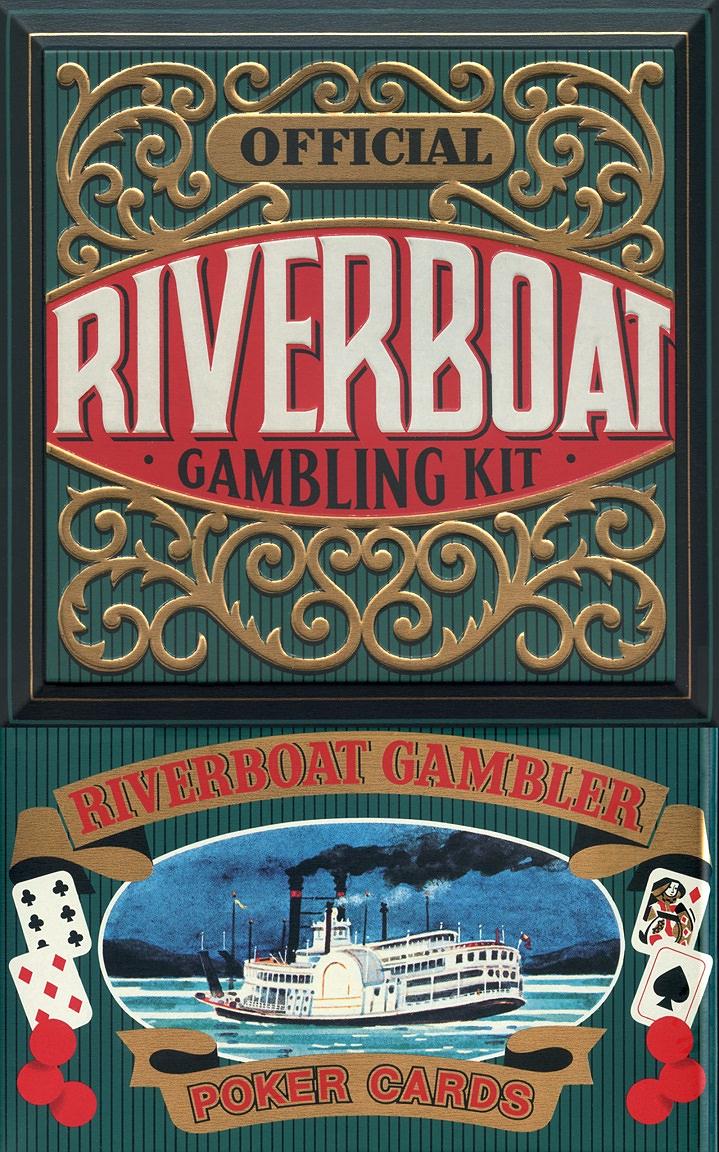
"RIVERBOAT GAMBLER" kit - tin box with lithographed graphic lettering and graphics
Nice whiz-bang tin box with hinged lid . . .
"RIVERBOAT GAMBLER KIT" which apparently had contained Poker Cards and Poker Chips Lid measures 5 1/2 inches square
Side with sidewheeler art in oval vignette measures 3 1/4 X 5 1/2 inches.
On bottom is printed CONTAINER MADE IN ENGLAND exclusively for CASE MANUFACTURING CO. NEW YORK 10013
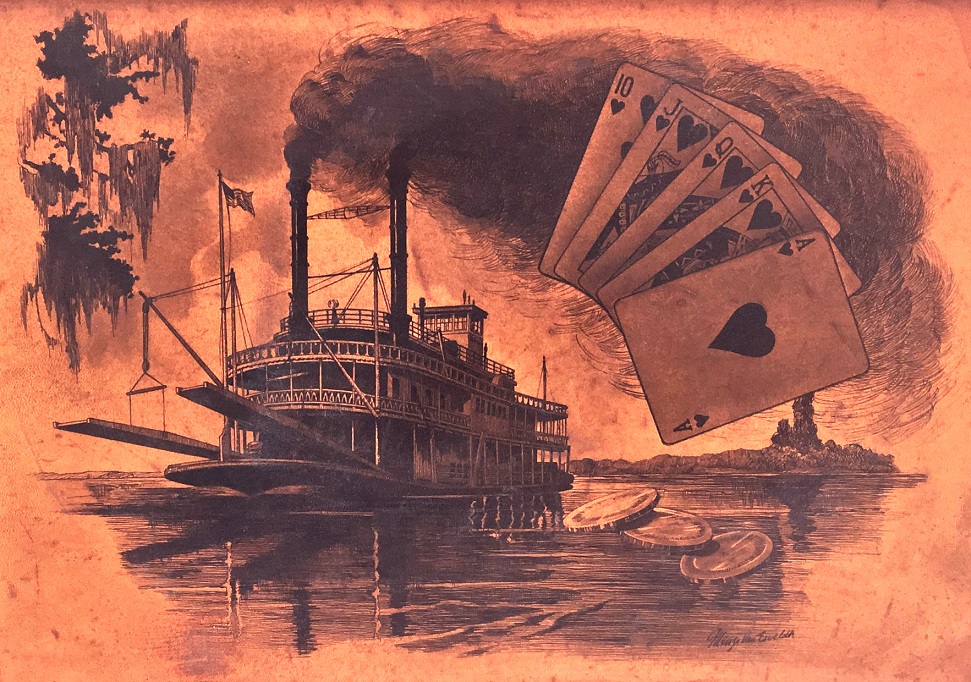
Steamboat and poker hand of hearts
"Game box" lid for a poker card game box set measuring 11 x 16 inches Pen and ink wash illustration of a steamboat, 5 card Royal Flush (Hearts) and 3 poker chips.
On the backside of the lid are instructions addressing the following: "AUTOMATIC COUNTING TRAYS" and "CHANCES OF BETTERING A HAND ON THE DRAW"
The artist's signature in the lower right hand corner of the lid graphic is difficult to read but looks could be of Dutch origin something like: "Mentze Van Eveleth." Not dated but possibly from the 40's or 50's.
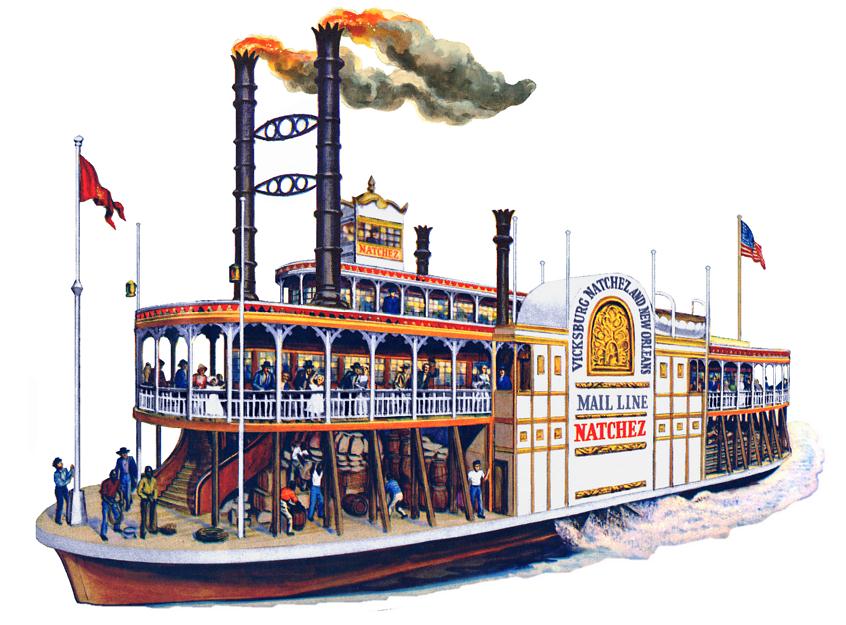
Attached colorful graphic that I cut out in Photoshop and put over white from a jig saw puzzle box. Ain't it perfectly enchanting though?
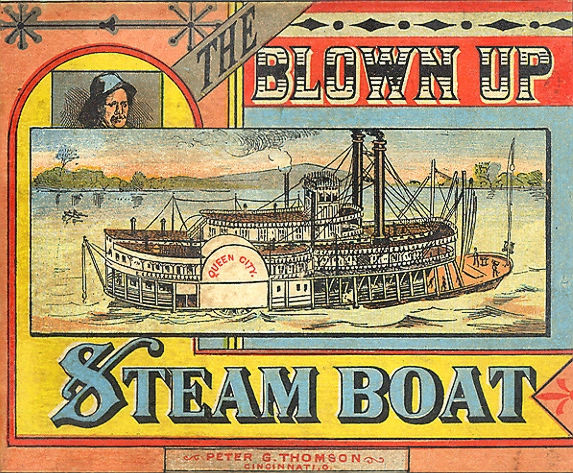
Cover of the little box (5 X 6 inches) containing a sort of a jig saw puzzle of a side wheel Queen City. The puzzle pieces are actually just a bunch of trapezoidal shaped pieces so they don't interlock like a jig saw would. Assembled the whole thing measures 12 1/4 X 16 1/4. This could possibly represent the second sidewheel Queen City 1851 - 1859. There are no swinging stages in either of the graphics so possibly this predates the Civil War! Kind of hard to believe but the design and antiquity of the box and puzzle make it seem possible. The manufacturer Peter G. Thomson is no relation that I know of but he spelled his name "right." (Detail below.)
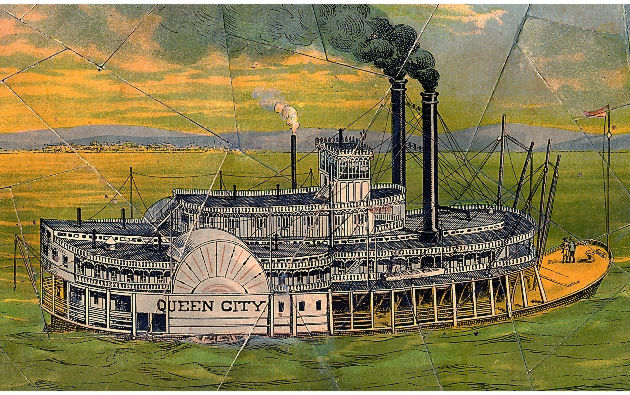
Queen City Puzzle box.
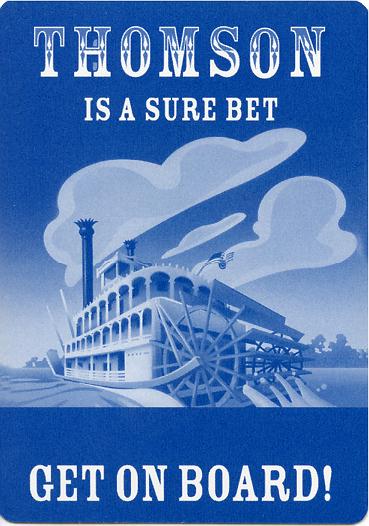
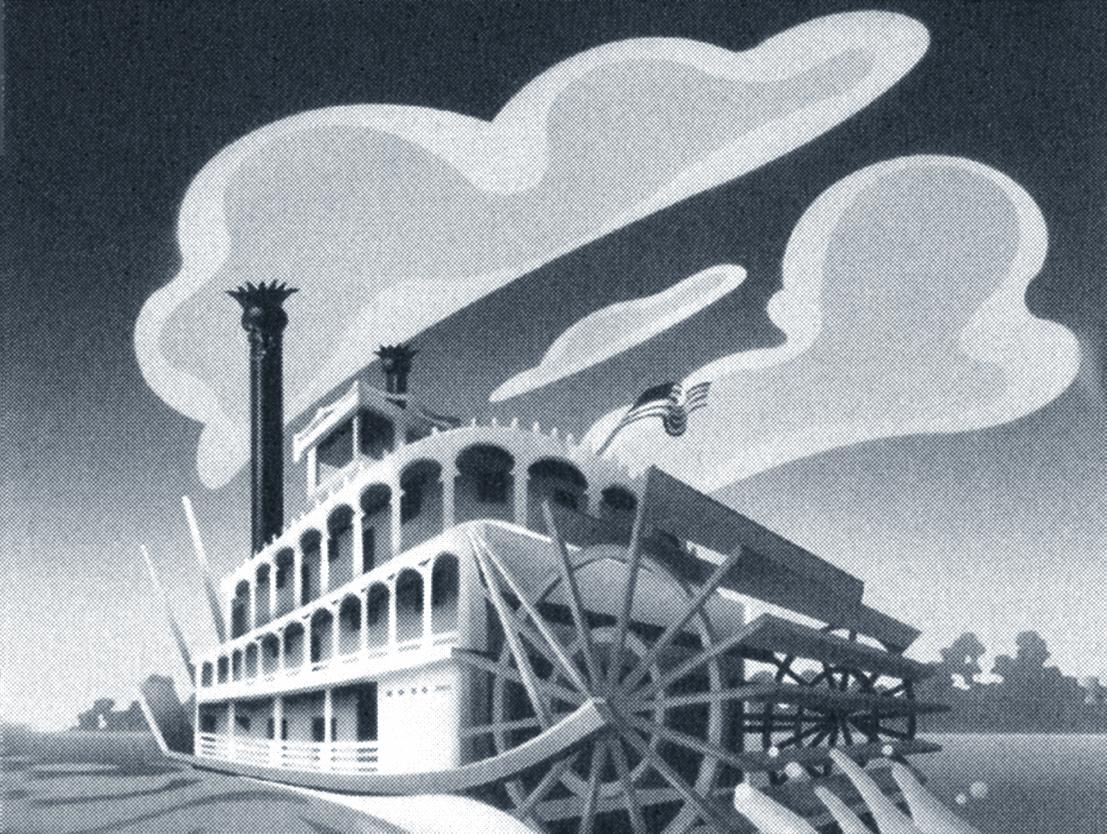
Scan of stylized steamboat graphic on the back of a playing card. It is just a coincidence the cards are marked "Thomson." Dave Thomson does not own a casino.
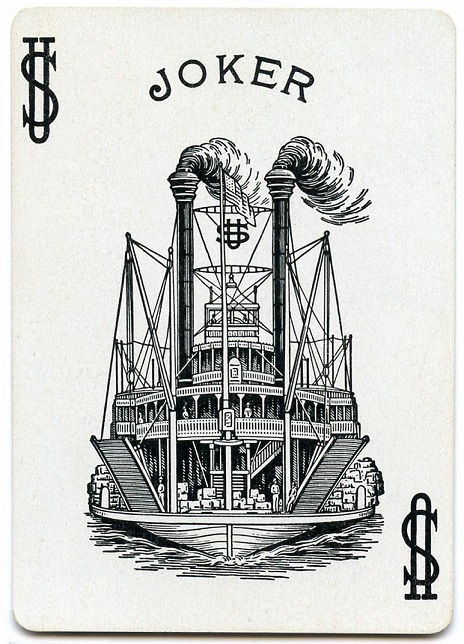
This steamboat "Joker" was from the US Playing Card Company's edition of the Steamboat 999 deck first introduced in 1883 by Russell, Morgan & Company.
The deck was in production for over a century before being discontinued but now "Dan and Dave" offer a reproduction of a deck of Steamboat 999 playing cards: dananddave.com
License Plate Steamboat Deco
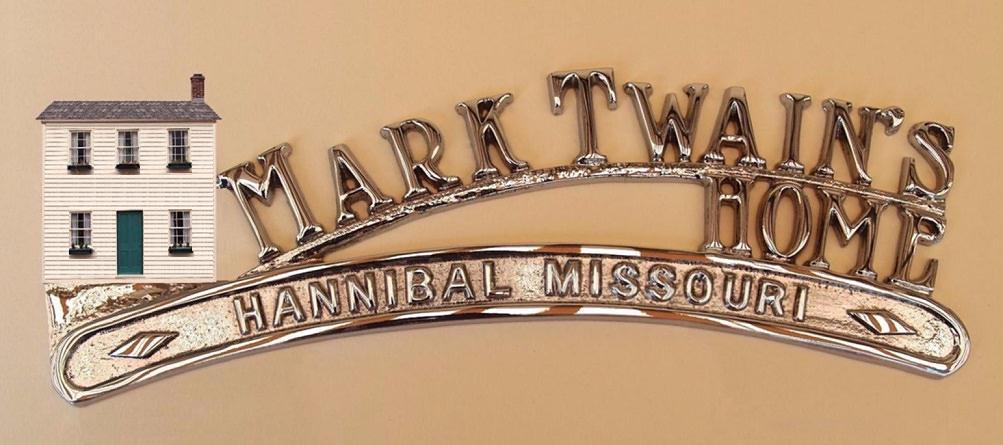
License Plate "topper" HANNIBAL, MO
Hannibal, MO vintage automobile license plate "Topper" that I had chrome plated. After photographing the Topper outdoors on the patio under the striped awning I opened the file on the computer and added a photo I had taken of the Boyhood Home as it looks today and finessed it to fit where a vague bas relief impression of the Home had been on the Topper. I also used the lettering from the topper in a composite of Jim Waddell standing in the foreground with the town of Hannibal in the distance on the west bank of the Mississippi River.
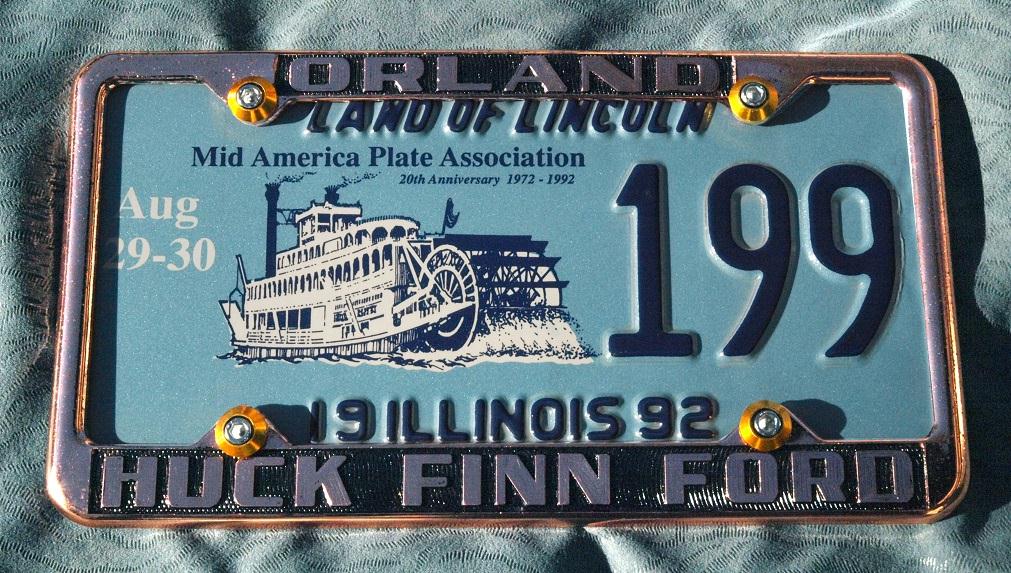
Julia Belle License Plate in Huck Finn Ford frame
JULIA BELLE on a 1992 Illinois license plate with copper plated frame for HUCK FINN FORD from the Northern California town of Orland.
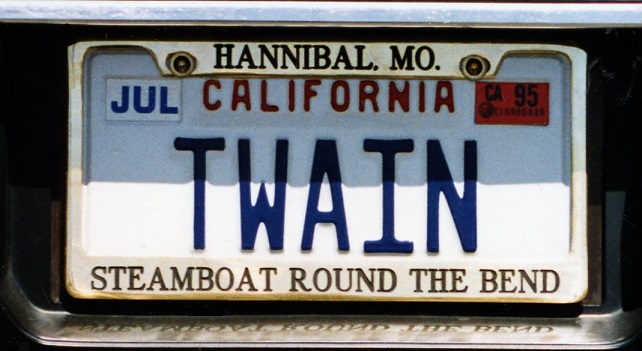
My personalized license plate and custom topper - Mid 1990's.
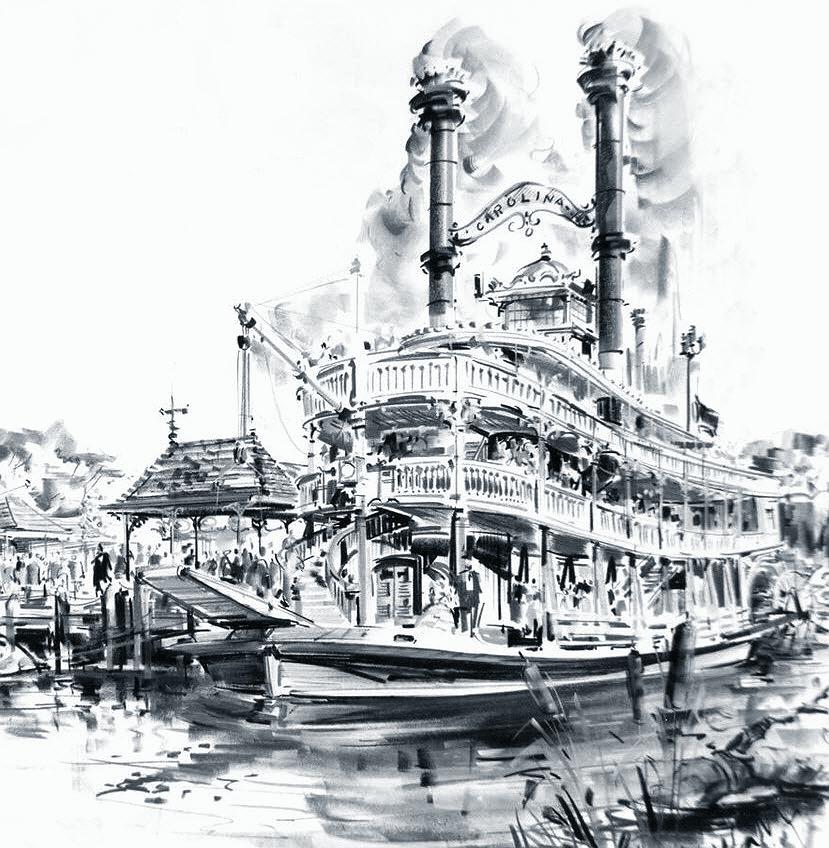
CAROWINDS Charlotte NC and the CAROLINA sternwheeler
Wikipedia
Carowinds is a 400-acre amusement park, located adjacent to Interstate 77 in Charlotte, North Carolina. Although having an official North Carolina address, the park is located on the state line of the Carolinas, with a portion of the park also located in Fort Mill, South Carolina. carowindsearlyyears.com
The Carolina Sternwheeler was an impressive paddle boat that docked in Plantation Square for the CAROWINDS theme park's during its first 30 years.
This relaxing trip for up to 400 passengers would take you by each of the park's 7 themed areas. Music was provided on board by the Dixieland Band. The water in the lagoon was only 6 feet deep and the boat traveled on a rail beneath the water. The Sternwheeler was removed after the 2003 season and replace by of a new flying roller coaster named Nighthawk (formerly known as BORG Assimilator)
carowindsearlyyears.com
E. Pat Hall, a Charlotte industrial developer, stunned the Carolinas on October 10, 1969 when he announced his plans to build a $250 million theme park and resort development that would straddle the NC/SC border near Interstate 77. Seven themed areas would depict more than 200 years of colorful Carolina history!
The $30 million theme park would be designed by Randall Duell & Associates of Santa Monica, CA., the same folks who designed Disneyland. A series of artistic renditions were released to the public in 1969 and ground was finally broken on May 1, 1970. The General Contractor was Charles Cisne & Associates of Charlotte. Their plans were to have the park open in April 1972, but rainy weather caused numerous construction delays.
Carowinds finally opened it's gates to the public on a rainy, March 31, 1973 at 9:36am. About 3,100 people passed through the turnstiles on that rainy, opening day, much less than the 25,000 anticipated. Fortunately, the first season ended with an impressive 1.2 million visitors, a record it held for a number of years when the impending oil crisis substantially hurt the travel and tourism industry. And amid the multiple park ownerships & personnel changes, come the inevitable and often drastic transformations that are necessary to remain fresh and competitive. The old Carowinds today, is barely recognizable with the exception of a few original rides and buildings. All of the down home, local charm that made Carowinds that special place it was back then, are long gone.
Many of those who visited Carowinds in it's hey day may recall certain thrill rides like the Surfer, the Witchdoctor or White Lightnin'. Others will remember the exquisite Double-Decker, German-made carousel, the Carolina Sternwheeler, the Monorail or the 2 authentic Steam Engine trains. And others may simply remember the Cable Skyway, a spin on the Oaken Bucket or the trams that would take guests to the former Plantation House entrance.
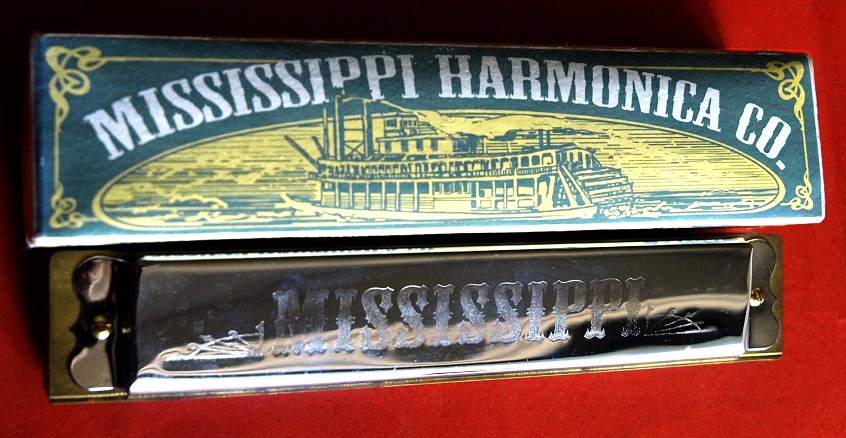
MISSISSIPPI HARMONICA CO.
REGAL No.96235 Made in CHINA 1990

Steamboat Woody Banjo Songs for Broken Hearts
Below is the YouTube link to my favorite Steamboat Woody song: Leaving & Living. Wish the lyrics were available also. The style reminds me of Bob Dylan's folk songs.
Leaving and Living, by Steamboat Woody
Published on Feb 5, 2019
Provided to YouTube by iMusician Digital AGYoutube
Steamboat Woody's home is in Québec, Canada
steamboatwoody.bandcamp.com
Banjo Songs for Broken Hearts
by Steamboat Woody - purchase options on website - digital or CD
Send as Gift!
1. Nowhere to Stay 02:46
2. Goin' East 02:37
3. Leaving and Living 03:26
4. PBR and Beef Jerky 02:43
Recorded by LoSpider at Swampland Records.
Artwork by Jérémie Guneau.
released April 15, 2016
all rights reserved
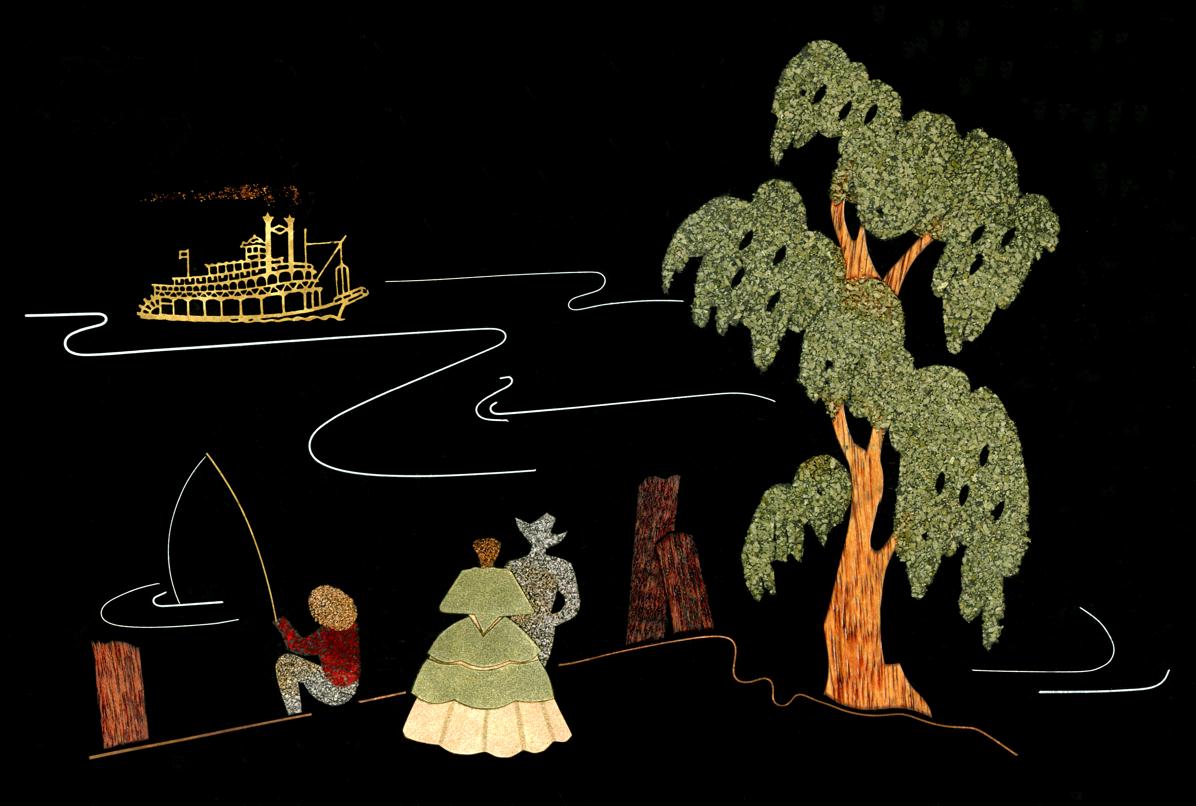
Vintage Couroc tray depicting a Mississippi riverboat scene
Vintage inlaid tray by Couroc depicting a Mississippi River steamboat in gold outline upper left. People on the bank with trees and one person is fishing at a dock. A boy is fishing left and a couple standin dressed in antebellum costumes in foreground. Measures 12 1/2 X 18 inches.
Tricky to scan and remove dust and scratches from black area. Brightened all the color components separately, captured them then pasted them into a darkened scan where the dust and scratches had been mostly subdued then spotting was needed to removed the remaining white dust.
The Couroc Company, founded in 1948 in Monterey, CA, produced beautiful and often whimsical black resin trays and glassware made by skilled artisans. See: thehourshop.com/collections/couroc
Couroc's founder, Guthrie Courvoisier, worked with a variety of plastics while working in the war effort during WWII. He used his experience and developed a proprietary formula of phenolic resin material that was not only durable enough to form into trays but was also impervious to alcohol and flames. Courvoisier's wife, Moira Wallace, acted as Couroc's chief designer and led an art commune of skilled artisans in arranging an array of local items into Couroc's resin pieces. Couroc's products were very popular and sold in high-end department stores. Alongside its whimsical designs, the company's saying for its trays stated that "Any tray can serve a drink. Only Couroc can start a conversation."
The company closed in the early 1990s.
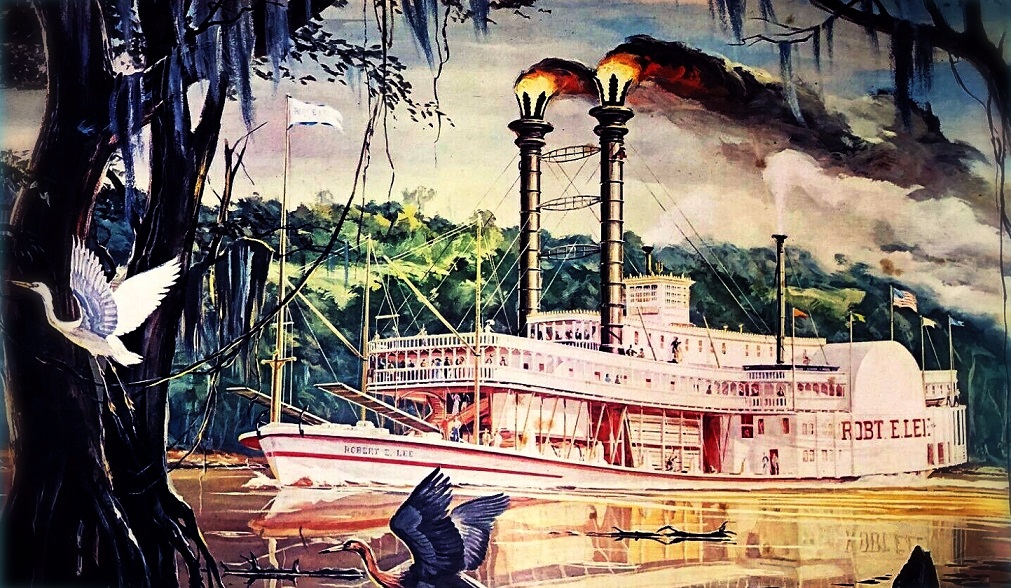
Painting on the box containing a Revell kit of the ROB'T E. LEE
Painting by an unknown illustrator on the box containing a plastic Revell kit of the ROB'T E. LEE from the 1950's.
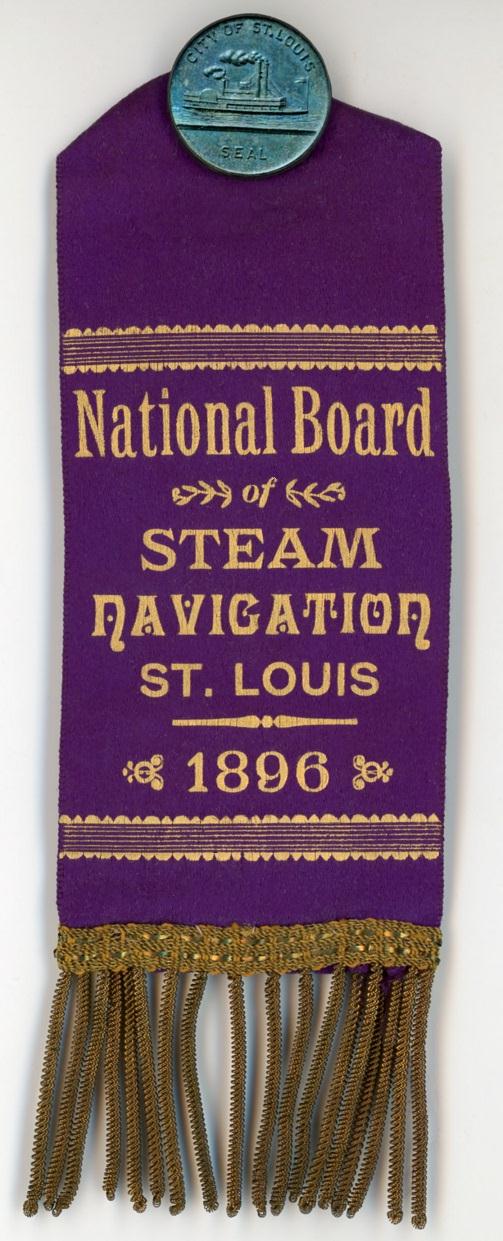
National Board of STEAM NAVIGATION ~ ST. LOUIS 1896
2.10 x 6.50 inches purple ribbon worn by attendees of a convention of the "National Board of STEAM NAVIGATION ~ ST. LOUIS 1896"
On the top is secured a .90 inch pin-back bronze medallion of the Seal of St. Louis that included a bas relief steamboat.
Not mentioned on the ribbon are the month, days and location that the convention took place but in May of 1896 a devastating tornado struck St. Louis with the loss of two of the Anchor Line steamers and damage to another one of theirs as per the following:
Wikipedia
"Historians say that the Anchor Line was ultimately doomed by the 1896 St. Louis-East St. Louis tornado that struck on May 27. The tornado touched down in the core of St. Louis and swept eastward across the river into East St. Louis, Illinois. The resulting death toll was a confirmed 255 people, though estimates put the number at close to 400. This is in part because the Anchor Line's floating palaces (as well as other steamboats) stationed at the St. Louis landing lay directly in the tornado's path. The Anchor Line's boats the Arkansas City and the City of Cairo were completely destroyed, and the City of Monroe was badly damaged."
Further information is given in posted in the following article on the National Centers for Environmental Information online site.
This Month in Climate History: May 27, 1896, St. Louis Tornado
ncdc.noaa.gov
Photo of the Eads Bridge after the May 27, 1896, St. Louis, Missouri, tornado
In crossing the river from the Missouri to the Illinois shore, the tornado tore away some 300 feet of the super structure of the Eads Bridge. Some of the stone blocks were hurled several hundred feet, and a wagon that was on the bridge was dashed to pieces with its two occupants. Credit: NOAA Photo Library
What remains the third most deadly tornado in U.S. history struck St. Louis, Missouri, on the afternoon of May 27, 1896, nearly 120 years ago. At the time, St. Louis hadn't experienced a major weather disaster in nearly 25 years, and the city had grown into a large metropolitan area. Shortly before five o'clock that Wednesday afternoon, the devastating tornado struck the city from the southwest, near the Compton Heights district. From there, the tornado made its way down the Mill Creek Valley, destroying countless homes as it headed toward the Mississippi River.
Once the tornado made it to the Mississippi, it decimated the steamboats and other vessels in the harbor, breaking them to pieces and scattering them from the Missouri shore to the Illinois shore. Even the Eads Bridge, which was considered "tornado proof" as the first major bridge constructed by making use of true steel, was damaged by the powerful tornado with nearly 300 feet of its eastern approach being torn away. Much of the central portion of St. Louis was also destroyed, as were factories, saloons, hospitals, mills, railroad yards, and churches throughout the city.
Across St. Louis, the tornado completely destroyed block after block of residential housing. Hundreds of miles of electric wires and thousands of telephone and telegraph poles were torn down by the fierce winds. The tornado also uprooted trees more than half a century old and hurled them a distance of several blocks. Heavy iron fences, like the one that surrounded Lafayette Park, were twisted and tangled until they were nearly unrecognizable.
During the less than half an hour that the tornado—which would most likely be rated as an EF-4 today—was on the ground, it tracked a three-mile-wide path of destruction across St. Louis, killing 255 people, injuring 1,000, and rendering countless families homeless.
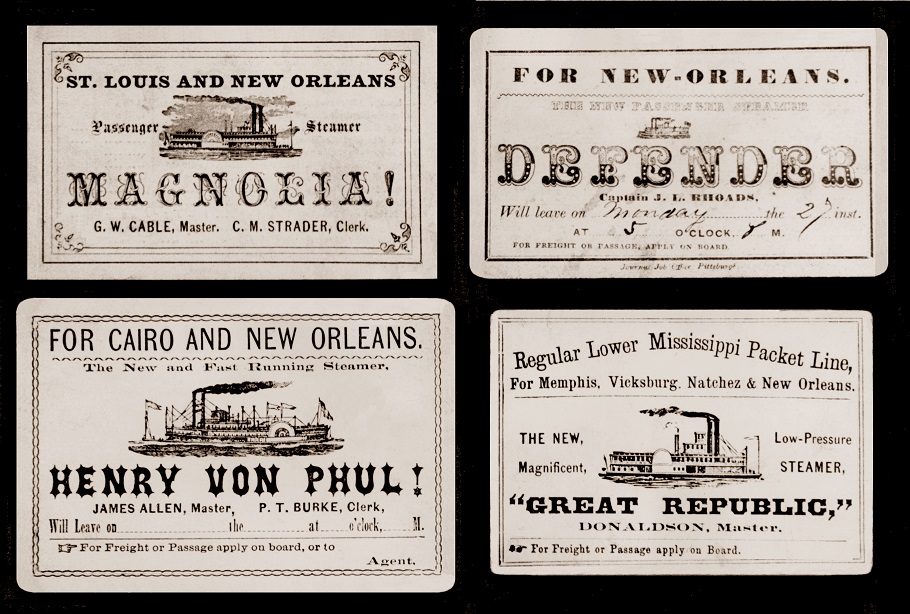
Antebellum Steamboat Cards MAGNOLIA, DEFENDER, HENRY VAN PHUL & GREAT REPUBLIC
Antebellum Steamboat Cards:
MAGNOLIA, DEFENDER, HENRY VAN PHUL & GREAT REPUBLIC
MAGNOLIA (1859-1868)
Sidewheel Packet
Way's Packet Directory Number 3698;
Built in 1859 at Cincinnati, Ohio
Owner and Master was Captain James H. Prather
First home port, Cincinnati, Ohio. She ran Cincinnati-Maysville.
On March 18, 1868 while upbound after leaving the landing at California, Ohio, her boilers exploded and the towboat PANTHER came to assist but 35 lives were lost. The burning wreck floated to Columbia before sinking.
DEFENDER
Sternwheel Packet
Way's Packet Directory Number 1483
Built Brownsville, PA 1855
1st homeport Pittsburgh
Sanagged and lost Apr 13 1860 at Laconia, Arkansas
HENRY VON PHUL
Sidewheel Packet
Way's Packet Directory Number 2608
Built 1860 at Paducah, Kentucky
Ran St. Louis - New Orleans
During the Civil War was a Hospital Boat Employed by the Union Army
Nov 15 1866 caught fire downbound above Donaldsonville, Louisiana.
GREAT REPUBLIC
Sidewheel Packet Boat
Way's Packet Directory
Number 2438
Built Shousetown PA and completed at Pittsburgh 1867
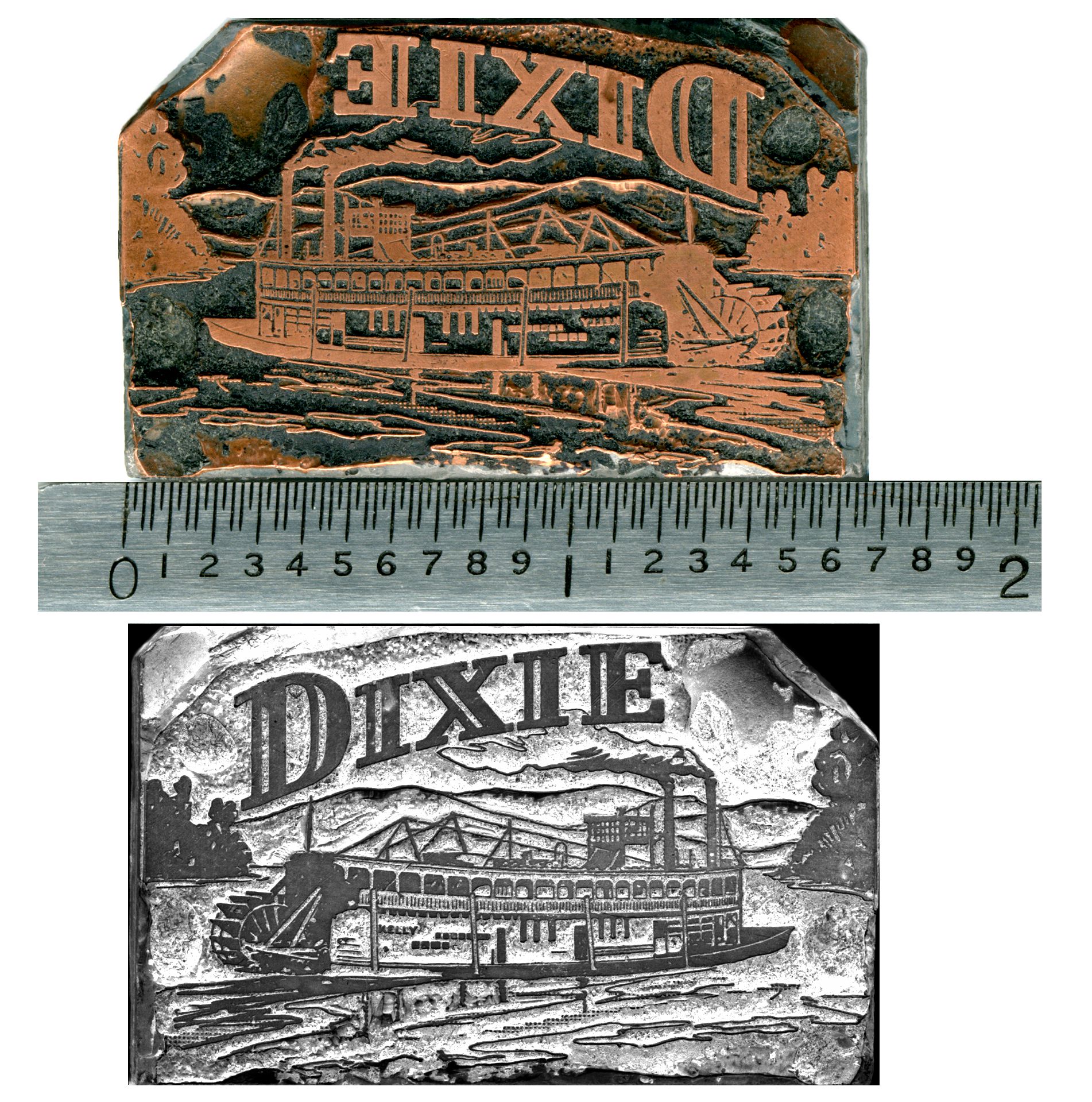
I "PROOFED" THE COPPER PLATED LEAD PRINTER'S BLOCK OF THE LITTLE STEAMER "KELLY" BY MAKING A MIRROR IMAGE OF IT IN PHOTO SHOP, CONVERTED IT TO GRAYSCALE AND ADJUSTED THE CONTRAST. SOMEDAY I'LL FIND A PLACE WITH A LETTERPRESS AND HAVE THEM MAKE A PROOF FROM THIS IN INK ON PAPER.
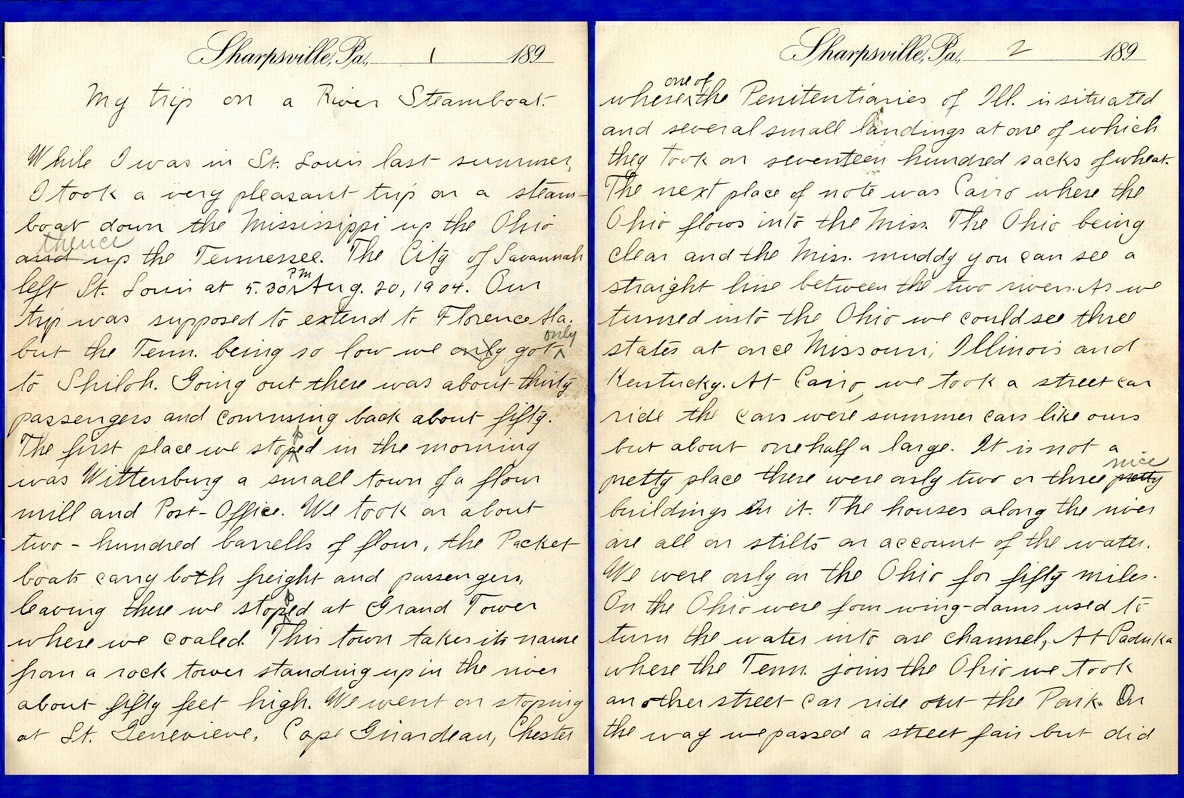
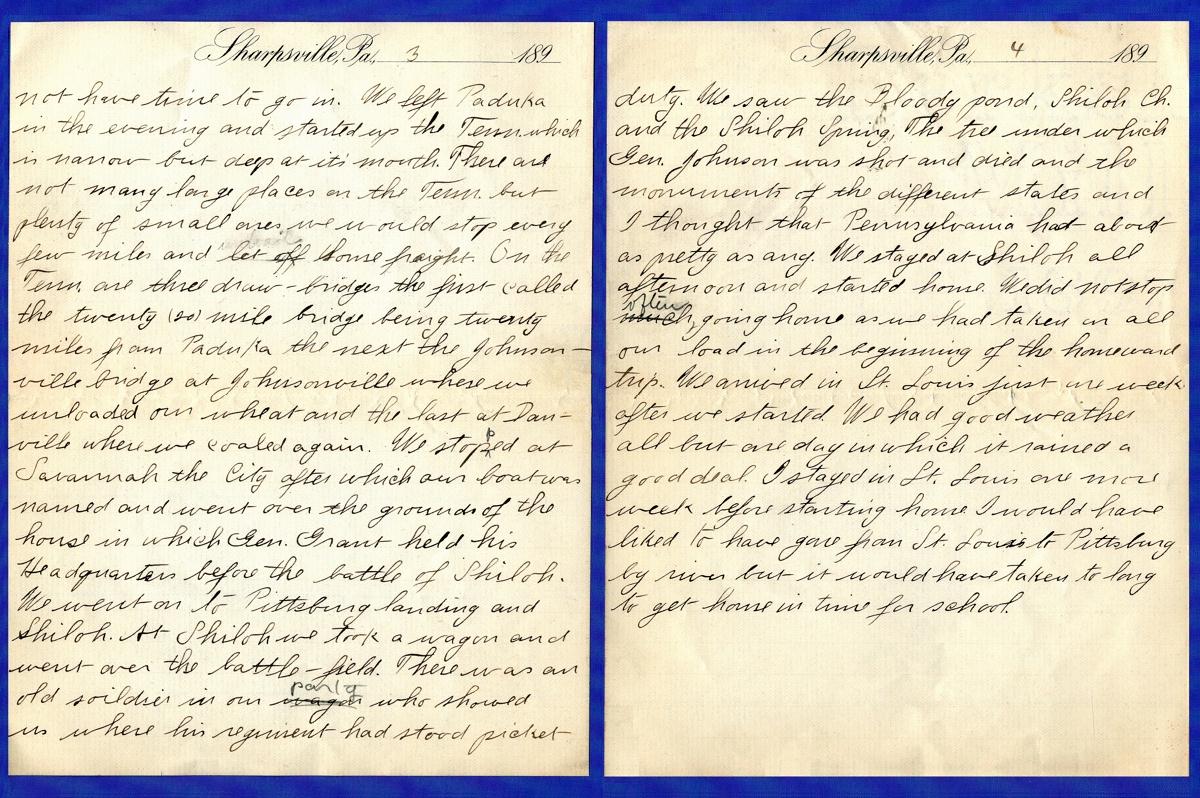
My trip on a River Steamboat. 1904
Transcript of a four page manuscript handwritten on Sharpsville, Pennsylvania stationery by an un-named Pennsylvania schoolboy about his trip on the steamboat CITY OF SAVANNAH commencing at St. Louis, Missouri on August 20th 1904, going down the Mississippi River to the Ohio and then up the Tennessee River to the Civil War battlefield at Shiloh.
My trip on a River Steamboat.
While I was in St. Louis last summer, I took a very pleasant trip on a steamboat down the Mississippi up the Ohio thence up the Tennessee. The CITY OF SAVANNAH left St. Louis at 5:30 PM Aug. 20, 1904. Our trip was supposed to extend to Florence, Alabama but the Tennessee being so low we got only to Shiloh. Going out there was about thirty passengers and coming back about fifty. The first place we stopped in the morning was Wittensburg a small town of a flour mill and Post-Office. We took on about two-hundred barrels of flour, the packet boats carry both freight and passengers, leaving these we stopped at Grand Tower where we coaled. This town takes its name from a rock tower standing up in the river about fifty feet high. We went on stopping at St. Genevieve, Cape Girardeau, Chester where one of the Penitentiaries of Illinois is situated and several small landings at one of which they took on seventeen hundred sacks of wheat. The next place of note was Cairo where the Ohio flow into the Mississippi. The Ohio being clear and the Mississippi muddy you can see a straight line between the two rivers. As we turned in into the Ohio we could see three states at once - Missouri, Illinois and Kentucky. At Cairo we took a street card ride, the cars were Summer cars like ours but about one half as large. It is not a pretty place, there were on two or three nice buildings in it. The houses along the river are all on stilts on account of the water. We were only on the Ohio for fifty miles. On the Ohio were four wing-dams used to turn the water into the channel. At Paducah where the Tennessee joins the Ohio we took another street car ride out to the Park. On the way we passed a street fair but did not have time to go in. We left Paducah in the evening and started up the Tennessee which is narrow but deep at its mouth. There are not many large places on the Tennessee but plenty of small ones. We would stop every few miles and upload some freight. On the Tennessee are three draw-bridges, the first called the twenty (20) mile bridge being twenty miles from Paducah, the next the Johnsonville bridge at Johnsonville where we unloaded our wheat and the last at Danville where we coaled again. We stopped at Savannah, the City after which our boat was named and went over the grounds of the house in which General Grant held his headquarters before the battle of Shiloh. We went on to Pittsburg landing and Shiloh. At Shiloh we took a wagon and went over the battlefield. There was an old soldier in our party who showed us here his regiment had stood picket duty. We saw the Bloody pond, Shiloh Church and the Shiloh Spring, the tree under which General Johnson was shot and died and the monuments of the different states and I thought that Pennsylvania had about as pretty as any. We stayed at Shiloh all afternoon and started home. We did not stop often going home as we had taken on all our load in the beginning of the homeward trip. We arrived in St. Louis just one week after we started. We had good weather all but one day in which it rained a good deal. I stayed in St. Louis one more week before starting home. I would have liked to have gone from St. Louis to Pittsburg by river but it would have taken too long to get home in time for school.
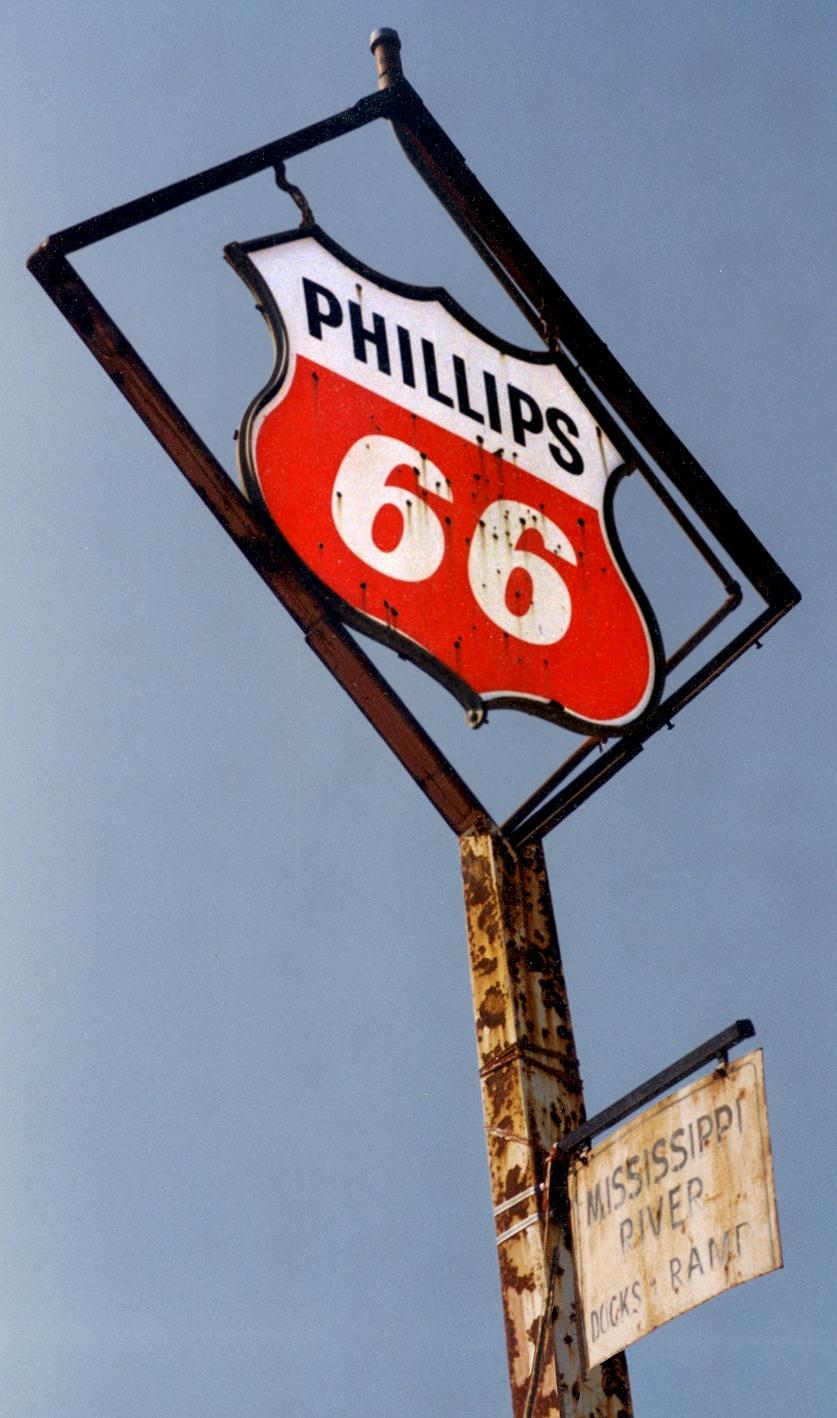
Photo I took in the 90s of one of my favorite signs (the one on the bottom that says MISSISSIPPI RIVER DOCKS & RAMP) which was on the river's edge at Canton, Missouri which is 37 miles north of Hannibal. I usually took the old 2 lane stretch of 61 so I could see the river and the small communities of La Grange and Canton during my drives north to Keokuk, Iowa where the towboat GEO. M. VERITY is on display.
Finally some years back when I made my pilgrimage the small River sign under the Phillips 66 sign had vanished, probably "harvested" by someone as a coveted piece of vintage highway and river ephemera.
Short history of Canton below from the Santa Fe Trail research site:
santafetrailresearch.com
Here on the Mississippi River, where wooded hills rise above the plains along the river, Edward White, Robert Sinclair, and Isaac Bland founded Canton, probably named for Canton, Ohio, in February of 1830. On the pioneer Salt River Trail, the town by 1860 was a thriving river port and trade center for the upper Salt River Country. A rival town, Tully, laid out adjacent to Canton, 1834, declined after the flood of 1851 and disappeared when Federal Lock and Dam No. 20 were built in the 1930's. During the Civil War, the countryside suffered from raids and recruiting sorties by Confederate and Union troops.
In the period after the war, Canton recovered its economic standing with the coming of the St. Louis, Keokuk, and Northwestern R.R. (now Burlington) in 1871.
Culver-Stockton College, founded by the Disciples of Christ here, 1853, as Christian University, is famed for having the first college charter in Missouri to assure equal education to men and women.
The present name, adopted, 1917, honors Mary E. Culver and R.H. Stockton, school benefactors.
Canton is the first town founded in the fertile Mississippi River county organized in 1833 and named for Meriwether Lewis.
Settled by Southern pioneers as early as 1819, Lewis County lies in territory ceded the U.S. by Iowa, Sac, and Fox tribes, 1824.
Westward is Montcello, the seat of Lewis County, laid out on the North Fabius, 1833. La Grange, south on the Mississippi, early river port and meat packing town, was laid out in April, 1830, near the mouth of the Wyaconda where Godfrey Le Seur is said to have had a trading post by 1795. Baptist Hannibal-La Grange College was chartered there as La Grange College, 1859.
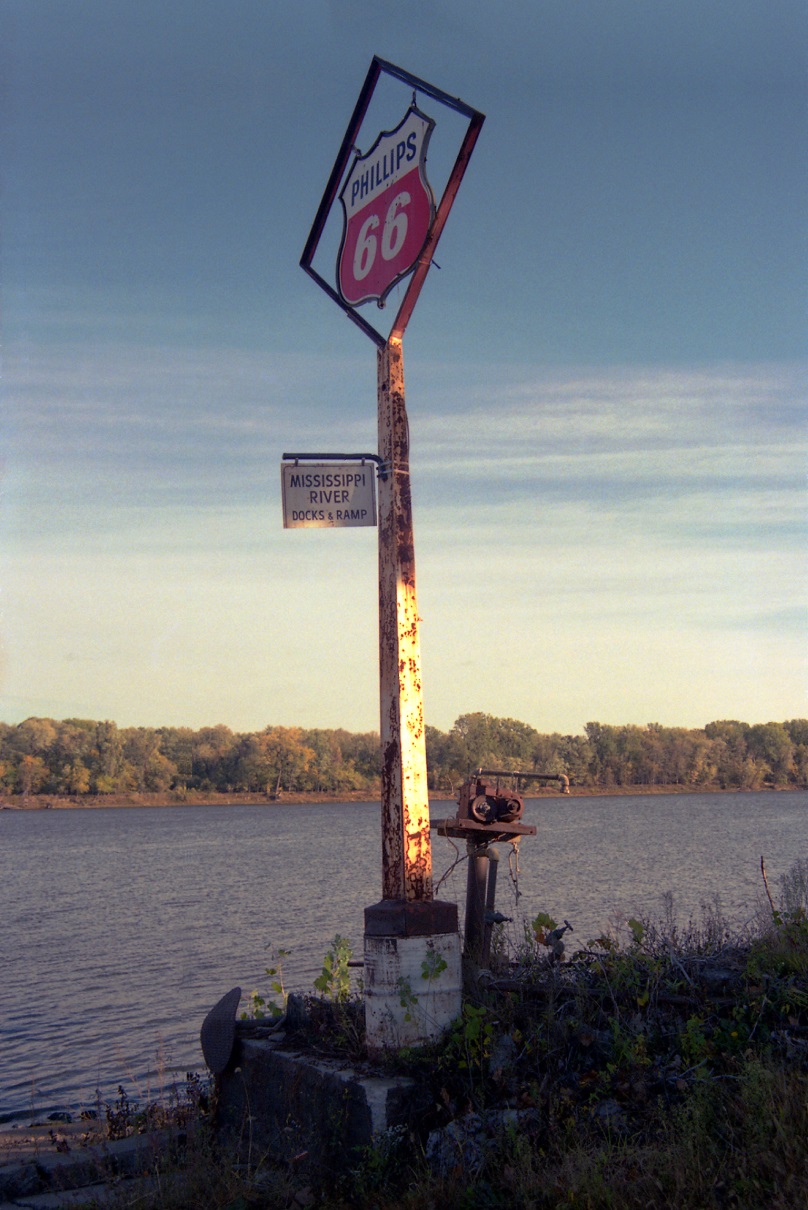
MISSISSIPPI RIVER DOCKS & RAMP signs at Canton, MO from 1988
Another photo I took of a pair of favorite signs (the one on the bottom says MISSISSIPPI RIVER DOCKS & RAMP) on the edge of the river at Canton, Missouri this time in October 1988 while driving north from Hannibal, MO to Keokuk, IOWA.
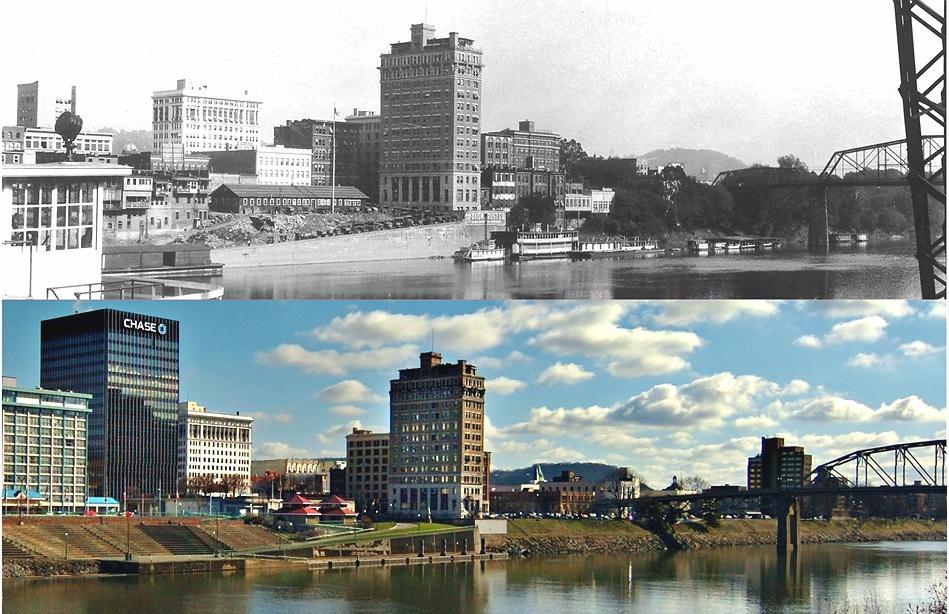

Charleston Daily Mail
Charleston, West Virginia
Monday, January 29, 2007
LOCAL HISTORIAN NOTES LANDMARK CRAFT, HOME OF OLD GENERAL SEAFOOD
This historic Charleston riverfront photograph was among a group of 45 recently purchased by California steamboat aficionado Dave Thomson.
The Sun Valley, Calif., resident collects model boats, photographs, documents and various other steamboat paraphernalia.
The Web site steamboats.com offers pictures from his collection.
When someone suggested this photo was of the Charleston, W.Va., riverfront, Thomson offered it to the Daily Mail for publication.
Local historian Richard Andre called this 1921 shot "a very interesting photo from an unusual vantage point."
"It was taken from the Ward ship yard and shows a riverboat pilot's cabin in the foreground while across the Kanawha River the rear of buildings along the Kanawha Boulevard live up to their reputation as eyesores."
Thomson says a close-up scan of the photo reveals the name "Edward's Moonlight" on the largest boat in front of the Union Building.
That's the same boat that in recent years served as a floating restaurant tied up at South Charleston's Riverwalk Plaza.
Now it has been pulled east to the Trojan Landing near the Patrick Street Bridge and is being renovated, again for use as a restaurant.
It was built in the late 1920s by Capt. Annis Boggs.
The spot where it is docked in the photo was known as Boggs' Landing.
It was towed by the Shamrock 2, the sternwheeler to the left of Edward's Moonlight.
Through the 1920s and 30s, the boat was used for dance cruises on the Kanawha River.
It was first called simply "Moonlight" and later rechristened "Edward's Moonlight" in honor of Boggs' son.
From the years of World War II through the mid 1980s, "Edward's Moonlight" was used for business purposes.
For many years it was leased by Amherst Industries and used as a dispatch barge.
Andre said the building with a row of windows just left of the Union Building is an old Army barracks donated to the Red Cross during World War I.
The Security Building is visible in the middle, and the Kanawha Banking and Trust tower can be seen to the left.
Also on the river at the levee is a wharf boat that served as a warehouse where steamboats could leave freight for local merchants, he said.
"This photo makes it obvious why the Boulevard was so welcome in 1940," Andre said.
In contrast, the recent river view photograph was shot by Daily Mail photographer Tom Hindman.
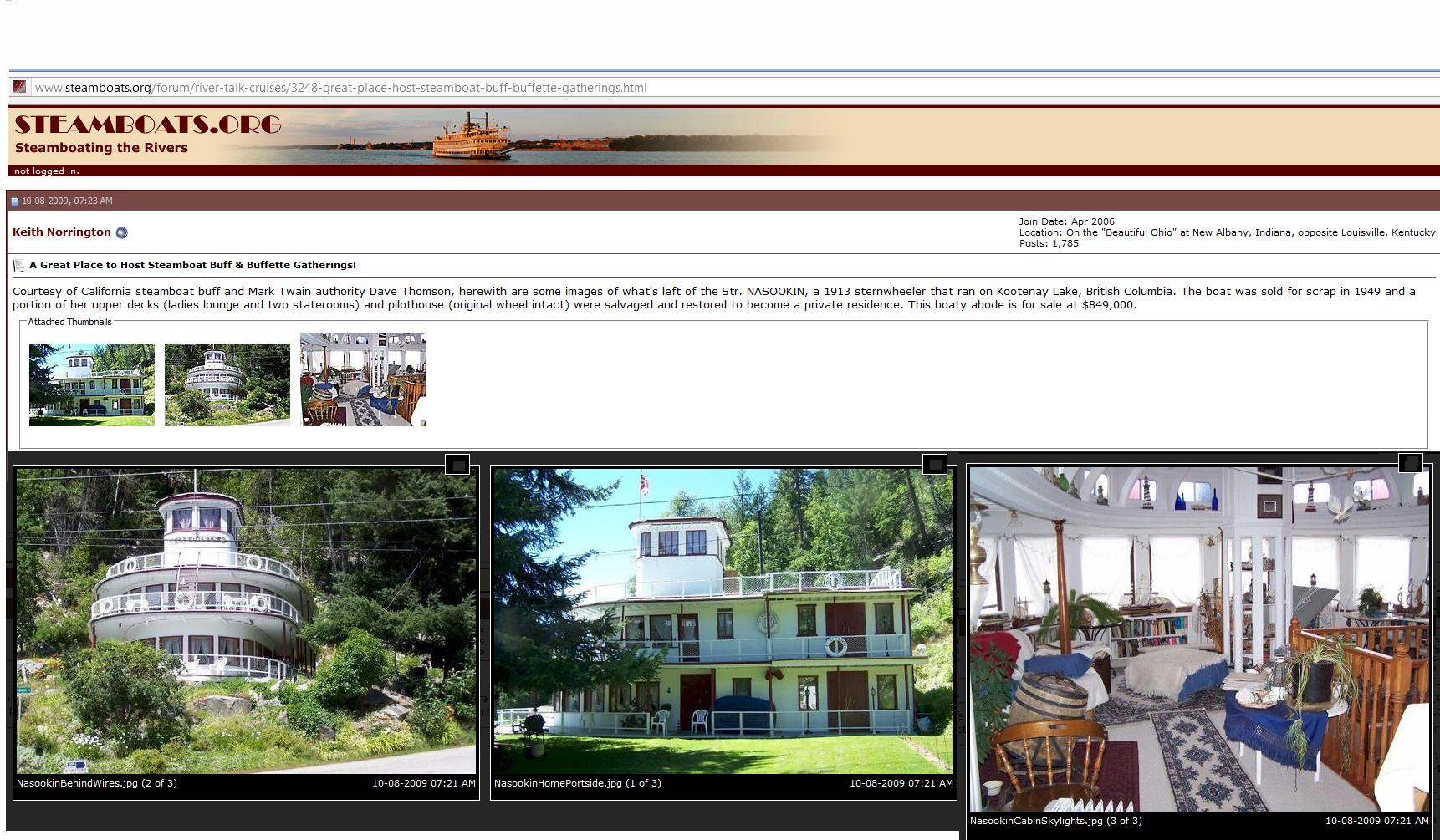
The Nasookin returns to Gray Creek nelsonstar.com
By Greg Nesteroff
The Nelson Star
October 06, 2011
Malcolm Metcalfe's earliest childhood memory is of being in the pilothouse of the SS Nasookin during the grand old ship's final days.
Once the largest sternwheeler on Kootenay Lake, it was by then a car ferry plying between Gray Creek and Fraser's Landing three times a day. Metcalfe's namesake grandfather, Malcolm MacKinnon, was its captain. Metcalfe recalls sitting on a shelf behind the ship's wheel.
"I remember my grandfather trying to get me to put my hand on this cord that came down from the ceiling and had a big tassel," he says. "I wouldn't touch it. So he pulled it, and of course it was the whistle. I screamed bloody murder."
That whistle blast is forever emblazoned in his memory - the only thing he can remember from that far back, much less with crystal clarity.
"My mother tells me I was two years old at the time. I told her that story, not the other way around. That's by far the earliest memory I have as a kid."
Metcalfe has a photo of himself with his grandfather, taken on that voyage, looking out the ship's front window.
He also has another memorable souvenir: the Nasookin's original wooden wheel. His grandfather received it when the ship was refitted as a ferry in 1933.
The modifications included removing an entire cabin deck, lowering the wheelhouse, and substituting a smaller steering wheel to fit the new dimensions.
The old wheel, which is 8.5 feet (2.6 metres) in diameter and weighs something like 150 lbs. (68 kilograms), sat in an attic at Capt. MacKinnon's Procter farmhouse.
He gave it to his daughter and son-in-law in the early '60s, who cleaned and varnished it, and in turn gave it to Metcalfe a little over 20 years ago. In all, it's been in the family's hands for nearly 80 years.
"We had houses in West Vancouver with high ceilings so the wheel stood proudly in our house," Metcalfe says.
However, when they moved to their current place, its much lower ceiling couldn't accommodate the wheel. Metcalfe and wife Linda had to decide what to do with it. They could give it to one of their children, but neither had met Capt. MacKinnon, who died nearly 30 years before they were born, nor had they spent much time in the Kootenays.
"So we thought that wasn't really appropriate. If I gave it to any of the rest of our family, same problem. Most of my cousins have moved all over."
Metcalfe started looking for a long-term home for the wheel where it would be well cared for and people could see it. Over several months "we sniffed around and found two or three options, but none really made sense."
Then by chance, they met one of their son's friends, who grew up in Gray Creek - the Nasookin's former terminus.
"Next thing I know I got a phone call from her mother, who was an active part of the Gray Creek Historical Society. Then Tom Lymbery called me. He knew my grandfather and sent pictures that showed him in Gray Creek with the boat."
Metcalfe explained his requirements for the wheel, and the society agreed to abide by them.
"I was absolutely thrilled to give it to them," he says.
The handover took place last month, and the wheel will be unveiled tomorrow at 2:30 p.m. in its new home at the Gray Creek store, where it will hang from the ceiling.
Lymbery's father Arthur founded the store in 1913 - the same year the Nasookin launched, with MacKinnon at the helm.
The store also took phone messages for the boat. According to Tom Lymbery, MacKinnon would wait a few minutes if someone phoned to say they would be late for the last sailing - unless the call came from Kuskanook, where there was a beer parlour.
The Lymberys have other pieces of the Nasookin, including the freight door and a small cabin door. The wheel was made of "very good quality wood," Metcalfe says. "I believe it's solid oak. It's very hard and very strong. I assume it was all hand-cut and put together piece by piece. It's a remarkable piece of work." Metcalfe, 67, was close to his grandfather, for shortly after he was born, his father went overseas with the air force.
Metcalfe lived with his grandfather and mother on the farm at Procter for about a year and a half, and he "was the only man in my life," until his father returned from war.
"He and I were always special friends until he died when I was seven, which was pretty traumatic for me," Metcalfe says.
Metcalfe grew up in Trail and worked for West Kootenay Power before moving to the Lower Mainland.
Capt. MacKinnon skippered the Nasookin until it was taken out of service in 1947. Part of its superstructure is now incorporated into a North Shore home.
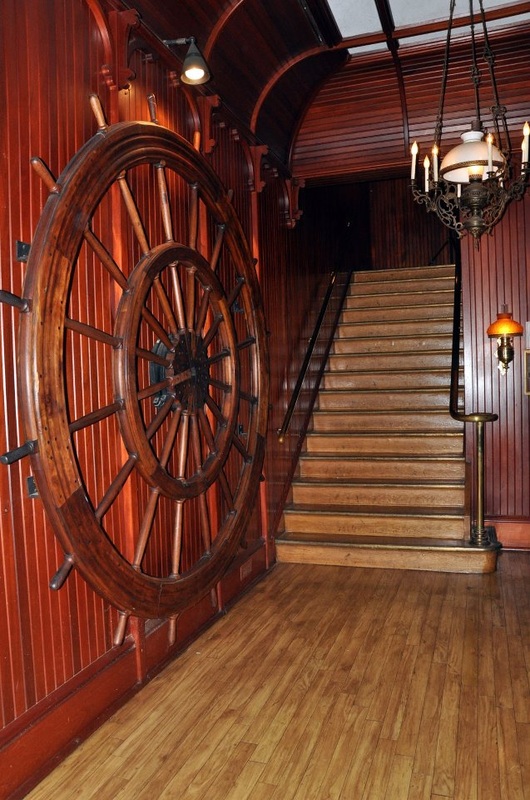
a fine pilot wheel in the entry of "The Belle Venue" in Memphis, Tennessee
THE "BELLE VENUE" IN MEMPHIS HAS AN EXTERIOR ENTRY THAT LOOKS LIKE A TRUNCATED STEAMBOAT STYLE WEDDING CAKE. AMONG THE PHOTOS ONLINE YOU CAN SEE THEIR FANCY VICTORIAN CEILING IN THE DINING ROOM WITH STEAMBOAT GINGERBREAD, BETWEEN THE CEILING AND "BULKHEADS," EVEN A "STERNWHEEL" AT THE REAR OF THE BIG ROOM WITH A PANORAMIC MURAL OF OLD MEMPHIS.
THE BEST THING THAT THEY HAVE IS WHAT HAS TO BE AN ORIGINAL DELUXE PILOT WHEEL IN THE ENTRY WHICH WOULD BE WORTH THE PRICE OF ADMISSION.
thebellebymaxx.com
The Belle Venue
"INSPIRED BY THE MAJESTIC RIVERBOATS OF THE MIGHTY MISSISSIPPI"
Looking for a unique facility for your next special event? The Belle Venue historical cruise themed event facility is the perfect place. This vintage ballroom with its majestic riverboat theme and historic elegant flair is a hidden treasure of the city.
The riverboat themed facility was originally built in 1973. It was a hospitality venue as the Schlitz Belle and later operated as the Stroh's Belle and later Coors Belle which is now known as "The Belle Venue". The Belle ballroom emulates an elegant riverboat overlooking a hand-painted mural of Mississippi River boats from yesterdays. The hand-crafted ceiling, tables and chairs, along with antique chandeliers and wall-mounted sconces reflect a Riverboat Theme while offering an incredible river view.
The historical landmark Grand Ballroom offers guests a grand facility for wedding, receptions, anniversary dinners, corporate events, galas, conferences, quinceanera, reunions, theme parties, proms, and more.
This unique ballroom accommodates up to 250 guests. The Texas Deck holds up to 75 guests and is an excellent space for showers, corporate meetings, Anniversaries, theme parties, and networking events.
The Belle provides historic charm, sophisticated elegance, and a location away from the crowded downtown area.
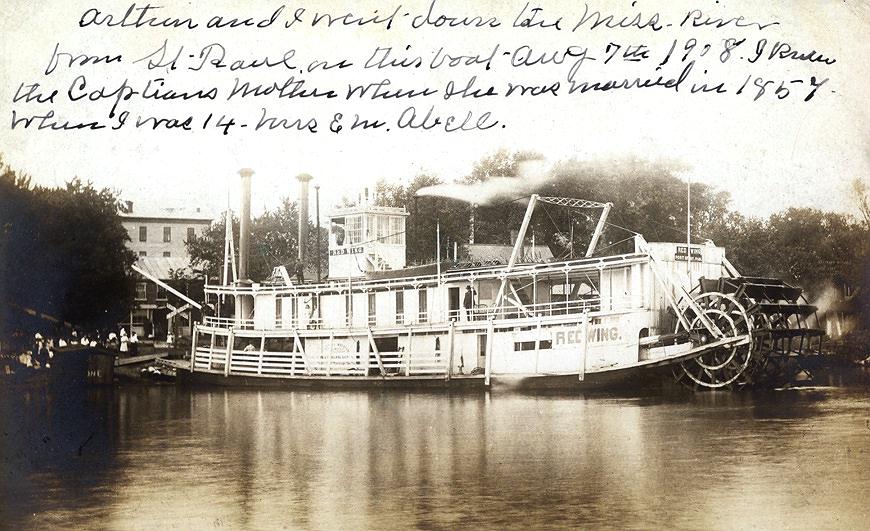
"Arthur and I went down the Miss(issippi) River from St. Paul on this boat-Aug 7th 1908. I knew the Captain's Mother when she was married in 1854 when I was 14. - Mrs E.M. Abell."
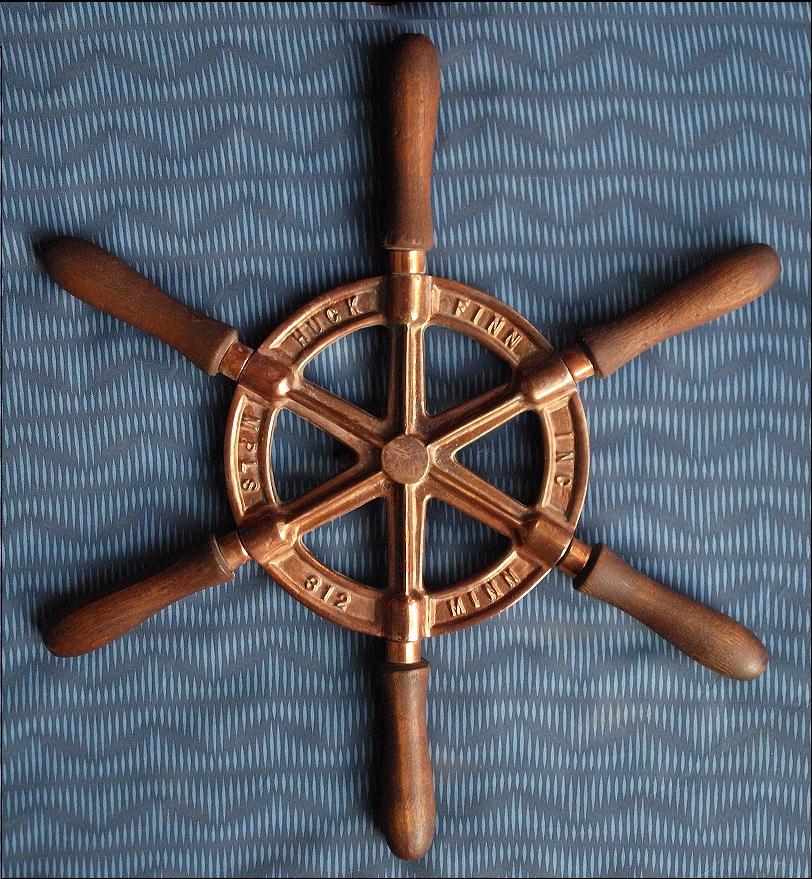
Photo of mini-pilot wheel manufactured by HUCK FINN Incorporated of Minneapolis Minnesota. This would fit on a pontoon boat or some other small craft. Measures 15 inches across, got it on eBay from a dealer in Niceville, Florida . . . the town's name would lend itself to be a title for a T.V. series about a superhero's boyhood hometown.
The metal portion originally had an aluminum finish, I had it copper plated, gave it a patina & re-stained the handles. Want to mount it on a circular wooden plaque for display eventually.
From a recent eBay listing of Stock Certificate Number 25591 for HUCK FINN Inc. Dated 11 April 1973
"Huck Finn, Inc. was incorporated in Minnesota and was based in Minneapolis, Minnesota
The company was produced a number of plastic/polyethylene products, covering a variety of industries.
Huck Finn patented a plastic beer keg, which was designed to reduce the weight of the keg compared to traditional metal kegs. The company also manufactured pontoon boats (one was known as the "Idle Hour") for consumers, featuring the company's patented pontoon system."
Photo of mini-pilot wheel manufactured by HUCK FINN Incorporated of Minneapolis Minnesota. This would fit on a pontoon boat or some other small craft.
Measures 15 inches across, got it on eBay from a dealer in Niceville, Florida . . . the town's name would lend itself to be a title for a T.V. series about a superhero's boyhood hometown.
The metal portion originally had an aluminum finish, I had it copper plated, gave it a patina & re-stained the handles. Want to mount it on a circular wooden plaque for display eventually.
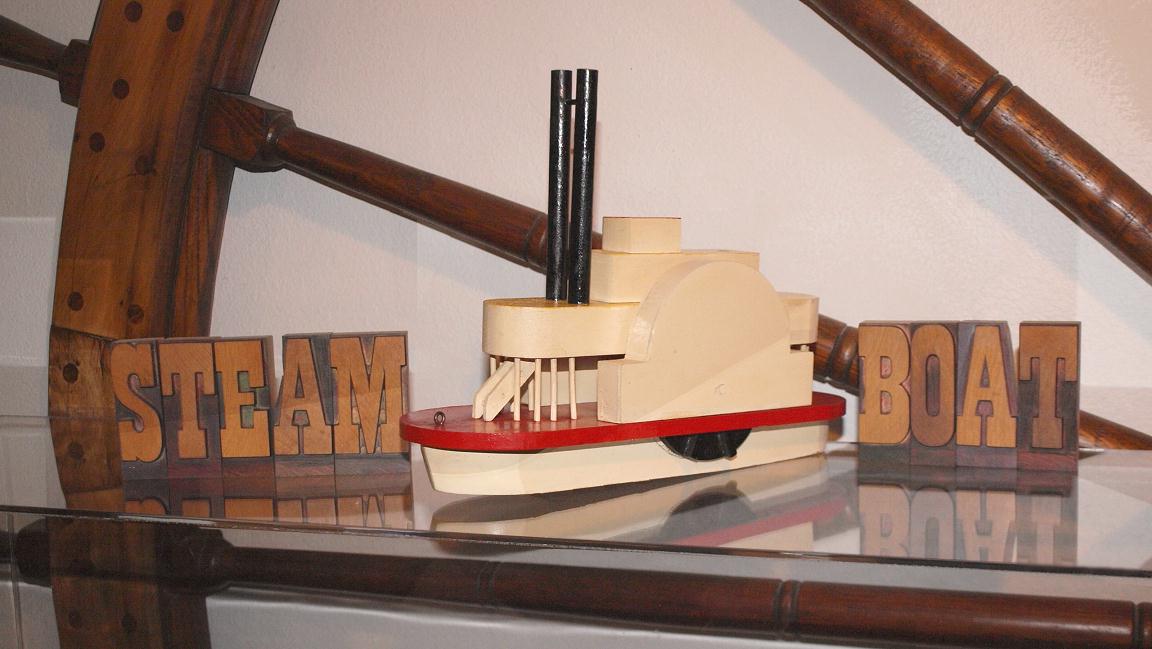
Concept of a sidewheel steamboat reduced to basic shapes as a child's pull toy, hand made of wood and painted. Circa 1970's. 12 1/4 inches long, 9 1/2 inches tall, 4 1/2 inches wide. Proportions of components in the model relied on "artistic license" rather than being "true to life." I posed the toy with some wooden display type, flipped the photo into a mirror image so the lettering would read correctly. Toy is symmetrical so it wasn't compromised when it became a "reflection." Pilot wheel from the PEERLESS against the wall behind the objects.
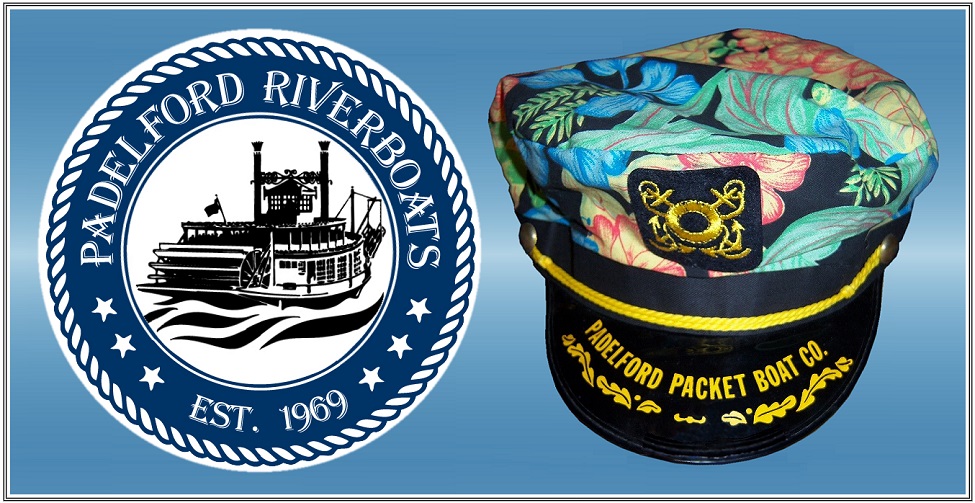
Padelford Riverboats LOGO and Souvenir Crew Cap
JONATHAN PADELFORD in winterquarters on the frozen Upper Mississippi River at St. Paul. We don't have a credit for this image but will be glad to give one if anyone knows who the photographer is.
Port Saint Paul, Minnesota
Built 1970 at Dubuque, Iowa
Captain Jim Kosmo
One of the few truly authentic sternwheelers on the Mississippi River, the all-steel vessel is named for the tenth great maternal grandfather of Capt. William D. Bowell, Sr., founder of Padelford Riverboats.
The engines are identical to the old steam engines but run hydraulically. The sound of the steam is still there. Its overall length is 125 feet with a 24-foot beam. Coast Guard licensed to carry 200.
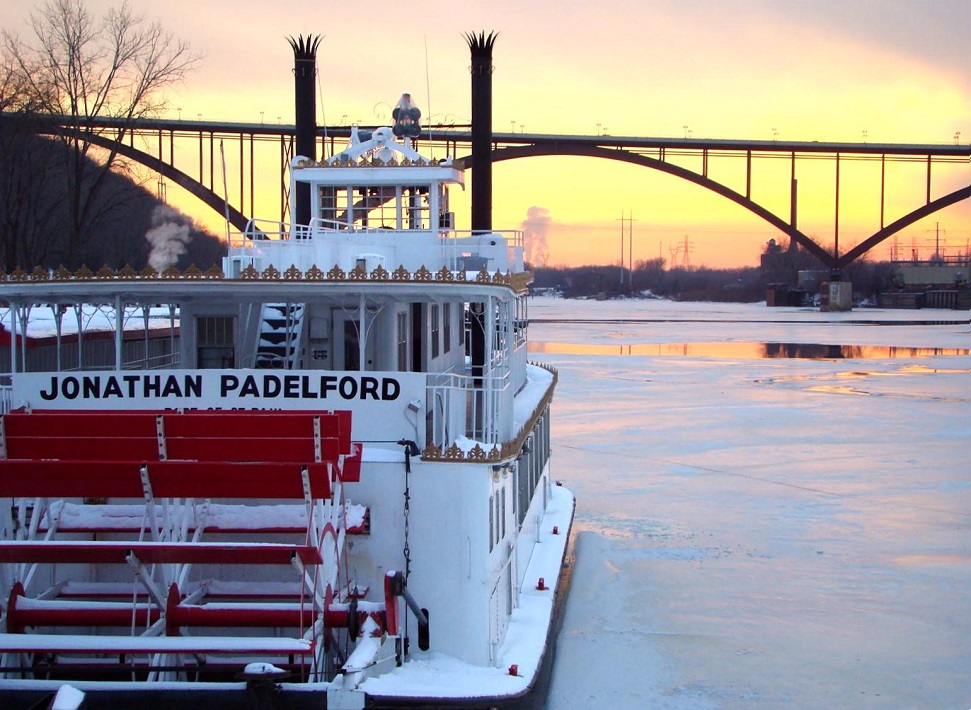
JONATHAN PADELFORD winter on the Upper Mississippi
JONATHAN PADELFORD in winterquarters on the frozen Upper Mississippi River at St. Paul. We don't have a credit for this image but will be glad to give one if anyone knows who the photographer is.
Port Saint Paul, Minnesota
Built 1970 at Dubuque, Iowa
Captain Jim Kosmo
One of the few truly authentic sternwheelers on the Mississippi River, the all-steel vessel is named for the tenth great maternal grandfather of Capt. William D. Bowell, Sr., founder of Padelford Riverboats. The engines are identical to the old steam engines but run hydraulically. The sound of the steam is still there. Its overall length is 125 feet with a 24-foot beam. Coast Guard licensed to carry 200.

With the exception of images credited to public institutions,
everything on this page is from a private collection.
Please contact Steamboats.com for permission for commercial use.*
All captions provided by Dave Thomson, Steamboats.com primary contributor and historian.
